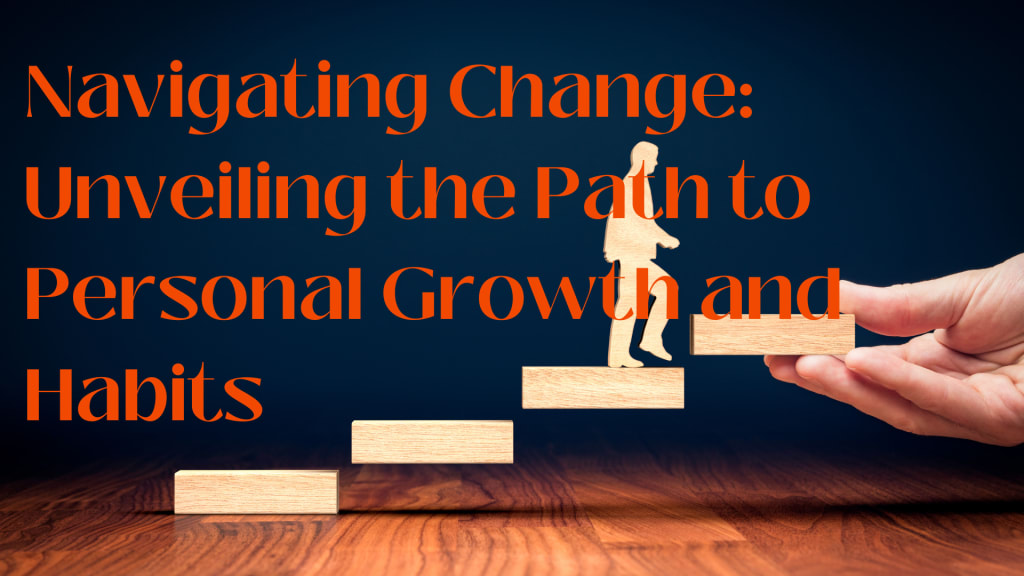Navigationg Change
Unveiling the paths to personal growths and habits

Many people see a difference between who they are now and who they want to become. This difference includes small tasks they want to do and bigger dreams they want to achieve. These dreams could involve things like exercising regularly, eating healthier, learning a new language, working on a creative writing project, reading more, or spending more time on meaningful hobbies instead of mindlessly browsing the internet.
But achieving these goals often means changing in important ways. You would need to become someone who is consistent, determined, disciplined, and strong-willed. You might have really tried to make these changes before and had some success for a short time. Unfortunately, it's common to then slip back into old habits, leaving you feeling disappointed. This cycle of trying and not succeeding can be really frustrating and make you mad at yourself. Sometimes, when you hear the idea of "success and hustle," it might feel like your fault for not wanting it enough and not having the willpower.
Making changes is tough. Think of it like going through a dense, hard-to-navigate jungle. Just like moving through that jungle takes a lot of effort, changing ourselves takes a lot of energy too. Our brains don't like using up too much energy, so they've come up with a clever trick. Every time you do something, your brain carves a path, like making a trail through the jungle. The more you do that thing, the clearer the path becomes. Over time, it turns from a rough trail into an easy-to-follow path, and then into a familiar route like a highway.
That's why change feels so hard, especially as an adult when our brains have these well-traveled paths. To understand how these paths form, we need to look at two things: routines and habits. Routines are sequences of actions we do the same way because they've worked for us before. Like making your favorite dish with the same ingredients in the same order because you like how it tastes. Or setting an alarm for a certain time to wake up. Imagine routines as plans made by a careful thinker. This thinker makes choices based on what we want in the future, even if they're not always comfortable.
With time, routines can become habits. Habits are things we do automatically without thinking about them. We've done them so much that they feel like rewards and solutions to situations. It's like going on autopilot. Habits start when we have triggers, which are signals that tell our brains to do an action. Triggers can be things we see, times of day, or places. An impulsive part of our brain, like a toddler, guides habits. This part is all about satisfying immediate wants and doesn't care much about the future. It goes for the easy path in the brain, the one it knows well.
Habits, whether good or bad, start because they feel good. This good feeling makes us want to do them again. Even bad habits form because they're pleasurable, like eating something tasty or scrolling through a fun website. This is why we keep doing them even if they're not good for us. The "toddler" part of the brain, even though it seems unhelpful, is important. It helps us deal with daily life by handling simple tasks, so our brain can focus on tougher challenges.
When we want to change, we can use this brain system to make it easier. We can focus on small changes instead of big ones. This is better than aiming high and making no progress. Small changes add up over time and can make a big difference. To build new habits, we start with routines and then let the "toddler" part of our brain take over. For example, if you want to be more active, you can start with a simple routine, like doing ten squats every morning. Pair this with clear triggers, like a specific time or place, so it becomes a habit.
Building habits takes time, and it might be tough. Creating new habits isn't as instantly satisfying as sticking to old ones. To make it easier, make the new action enjoyable. Listen to your favorite podcast while working out or do something fun while doing tasks you find less exciting. The important thing is finding what works for you. It might sound simple, but it's not always easy. The time it takes for new habits to become automatic varies, but it's possible for everyone, no matter their age. Even if you make just a little progress, it's better than staying unhappy and making no changes. Remember, change is about moving forward, not reaching a destination.
About the Creator
Jordan G
Avid writer and reader
Enjoyed the story? Support the Creator.
Subscribe for free to receive all their stories in your feed. You could also pledge your support or give them a one-off tip, letting them know you appreciate their work.






Comments
There are no comments for this story
Be the first to respond and start the conversation.